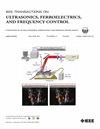Simulation, Design, and Characterization of a Large Divergent Element Sparse Array (LDESA) for 3-D Ultrasound Imaging
IF 3.7
2区 工程技术
Q1 ACOUSTICS
IEEE transactions on ultrasonics, ferroelectrics, and frequency control
Pub Date : 2025-06-25
DOI:10.1109/TUFFC.2025.3583178
引用次数: 0
Abstract
Sparse arrays address the complexity of manufacturing large 2-D arrays. However, they usually suffer from a low signal-to-noise ratio (SNR) due to their small element size. The large divergent element (LDE) technology overcomes this limitation by simultaneously having a large emitting area and a large angular aperture. The aim of this work is to demonstrate the feasibility of imaging in B-mode using the LDE sparse array (LDESA), that is, increasing the sparse array SNR without noteworthy impact on contrast. This article provides the simulation, the design, and an experimental characterization of a 1-MHz LDESA. Simulations are performed using the angular impulse response-based ultrasound simulation (AIRUS), providing coupled image-transducer optimizations of LDESA designs. Probe parameters, including probe diameter, layout, LDE size, and electroacoustic response, are optimized to maximize the contrast ratio (CR). The final layout is a 100-mm-diameter Fermat spiral covered by 256 LDEs. Each LDE is 3.5 mm wide in diameter and experimentally reaches an angular aperture of 75° at −6 dB in echo. The transmit focused beam is 1° wide and steerable up to 60° with an amplitude loss of only 10 dB. The array exhibits a 2.2-mm lateral resolution and a 1.8-mm axial resolution in a wire experiment.用于三维超声成像的大发散元稀疏阵列(LDESA)的仿真、设计和表征。
稀疏阵列解决了制造大型二维阵列的复杂性。然而,由于元件尺寸小,它们通常具有低信噪比(SNR)。大发散元件(LDE)技术克服了这一限制,同时具有大的发射面积和大的角孔径。这项工作的目的是证明在b模式下使用大离散元稀疏阵列(LDESA)成像的可行性,即在不显著影响对比度的情况下增加稀疏阵列的信噪比。本文给出了一个1mhz LDESA的仿真、设计和实验表征。使用基于角脉冲响应的超声仿真(AIRUS)进行仿真,为LDESA设计提供耦合图像换能器优化。探头参数,包括探头直径,布局,LDE尺寸和电声响应,进行了优化,以最大限度地提高对比度。最终的布局是由256个二极管覆盖的直径100毫米的费马螺旋。每个LDE的直径为3.5mm宽,在回波-6 dB时实验角孔径达到75°。发射聚焦波束宽度为1°,可调至60°,振幅损失仅为10 dB。在导线实验中,该阵列的横向分辨率为2.2 mm,轴向分辨率为1.8 mm。
本文章由计算机程序翻译,如有差异,请以英文原文为准。
求助全文
约1分钟内获得全文
求助全文
来源期刊
CiteScore
7.70
自引率
16.70%
发文量
583
审稿时长
4.5 months
期刊介绍:
IEEE Transactions on Ultrasonics, Ferroelectrics and Frequency Control includes the theory, technology, materials, and applications relating to: (1) the generation, transmission, and detection of ultrasonic waves and related phenomena; (2) medical ultrasound, including hyperthermia, bioeffects, tissue characterization and imaging; (3) ferroelectric, piezoelectric, and piezomagnetic materials, including crystals, polycrystalline solids, films, polymers, and composites; (4) frequency control, timing and time distribution, including crystal oscillators and other means of classical frequency control, and atomic, molecular and laser frequency control standards. Areas of interest range from fundamental studies to the design and/or applications of devices and systems.

 求助内容:
求助内容: 应助结果提醒方式:
应助结果提醒方式:


